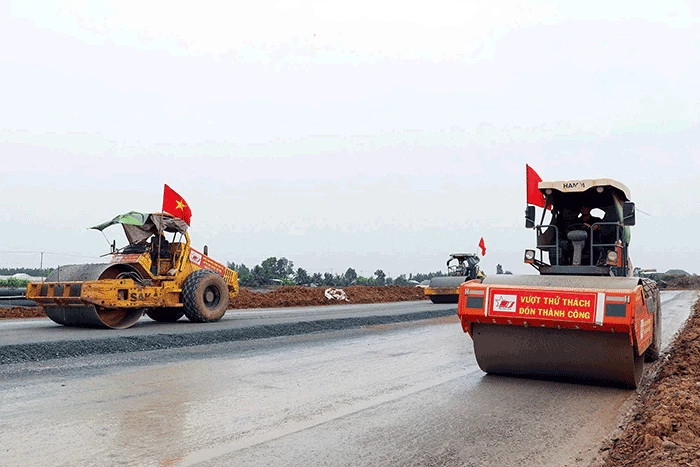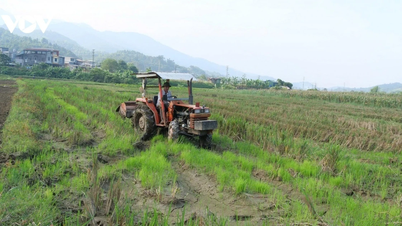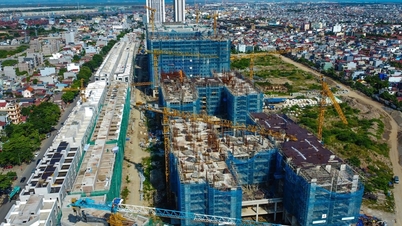Institutional bottlenecks for public investment need to be removed to boost growth. Photo: Construction of the Can Tho - Ca Mau Expressway (Can Tho - Hau Giang section).
Challenges in the reform process
“Vietnam's economy has grown five times (at comparable prices) compared to 30 years ago. A sustained high real growth rate of 5% to 6% over three decades is an achievement that very few countries can achieve,” said the World Bank (WB) report Vietnam 2045 - Breakthrough: Institutions for a High-Income Future. Over the past 10 years (2013-2024), the size of Vietnam's economy has doubled, and during this time, the total assets of the banking sector have quadrupled, the capitalization on the stock market has increased to nearly 70% of GDP, outstanding government bonds have increased to nearly 18%, budget expenditures have increased 1.6 times, etc. Vietnam's institutional reforms have created new growth drivers, the private economy is growing stronger and making a very important contribution to the national GDP. In addition, assessments of the level of competitiveness in the economy achieved quite good results.
The WB report also stated that institutional reforms have significantly increased the efficiency of public investment. Vietnam's public investment system has brought about much better infrastructure than in previous decades. Public investment is one of the three pillars of Vietnam's growth in recent years. Experts say that proper public investment will boost productivity, attract investment from businesses and bring growth, improve transport infrastructure connectivity, etc. And to become a high-income country by 2045, Vietnam needs public investment at 7.3% of GDP per year. However, the current public investment institution has not kept up with demand. For example, in 2024, the public investment disbursement rate was only 77.5%, far lower than the average of 95% in upper middle-income countries and 96% of the average of high-income countries. “The rapid transformation into a high-income country requires attention to public investment in both quantity and quality,” the WB report stated. Therefore, institutions on public investment management need to be improved, both in terms of decision-making efficiency, financial allocation and decentralization to localities… to meet the public infrastructure needs to serve growth.
In addition, institutions for the private sector also need to be promoted more quickly. Because surveys by a number of international organizations have shown that although efforts to create a business environment and simplify administrative procedures have been widely implemented nationwide, with the responsible participation of public agencies, over 35% of businesses still believe that they have to spend at least 10% of their time to learn and handle regulations. When the cost of complying with legal regulations for businesses is high, it is also a barrier for the private economic sector to develop.
Ms. Mariam J. Sherman, World Bank Country Director for Vietnam, Cambodia and Laos, commented: “Recent reform efforts demonstrate Vietnam’s determination, but to achieve the goal of becoming a high-income country by 2045, Vietnam needs to implement more drastic reforms – “a breakthrough institutional push” – to maximize the potential of the private sector in promoting growth and creating quality jobs for the people.” Vietnam needs to be stronger in the process of institutional reform, strengthening the legal system and legal environment… to create breakthroughs for the next stage of development.
Need for breakthrough decisions
WB experts recommend that to become a high-income country, Vietnam needs to build an effective public service apparatus with clear accountability. In particular, there needs to be a reform package to optimize state management capacity at all levels. In particular, focusing on strengthening the leading and creative role of the central budget to promote resource coordination mechanisms between government levels in providing comprehensive infrastructure services at regional and national levels to serve growth, green transformation, and climate change adaptation. At the same time, strengthen the initiative and accountability of local governments; promote the balance between the goals of equity, efficiency, and sustainability (emphasizing reform of budget allocation methods for development goals and plans); improve the capacity of cadres, civil servants, and public employees in the public service apparatus to perform public duties better and more effectively.
With the goal of promoting the institutional reform process to create a more transparent and open investment and business environment, policies for businesses, especially the private sector, also need to be calculated more carefully, especially reducing transaction costs for businesses. Vietnam has begun to implement a series of institutional reforms to have a more streamlined and effective civil service. The current efforts to streamline the apparatus are an important premise to create new breakthroughs for a better developed Vietnam in the coming period.
Along with institutional reform, Vietnam also needs to strongly shift to green growth to minimize risks and better respond to the challenges of ongoing climate change. The WB report “Vietnam 2045 - Greener Growth: The Path to a Sustainable Future” has pointed out that without timely adaptation measures, the impact of climate change could cause the Vietnamese economy to lose about 12.5% of GDP by 2050 compared to the baseline scenario, making this threat more serious to the aspiration to realize the goal of becoming a high-income country by 2045. However, if there are good adaptation policies and effective investment, the loss can be reduced to 6.7%...
Many experts believe that Vietnam has many advantages in development thanks to its stable political environment, and its investment environment is also highly appreciated by foreign investors and businesses. Vietnam is developing a pivot in technology, especially in the fields of high technology, semiconductors, green energy, etc. In addition, the private economic sector is increasingly growing and playing the role of a driving force for growth, which will be an important premise for Vietnam to reach a new level.
Article and photos: GIA BAO
Source: https://baocantho.com.vn/cai-cach-the-che-tao-dong-luc-cho-tang-truong-kinh-te-a187733.html








































![[Photo] Cutting hills to make way for people to travel on route 14E that suffered landslides](https://vphoto.vietnam.vn/thumb/1200x675/vietnam/resource/IMAGE/2025/11/08/1762599969318_ndo_br_thiet-ke-chua-co-ten-2025-11-08t154639923-png.webp)









![[Video] Hue Monuments reopen to welcome visitors](https://vphoto.vietnam.vn/thumb/402x226/vietnam/resource/IMAGE/2025/11/05/1762301089171_dung01-05-43-09still013-jpg.webp)


















































![Dong Nai OCOP transition: [Part 2] Opening new distribution channel](https://vphoto.vietnam.vn/thumb/402x226/vietnam/resource/IMAGE/2025/11/09/1762655780766_4613-anh-1_20240803100041-nongnghiep-154608.jpeg)














Comment (0)